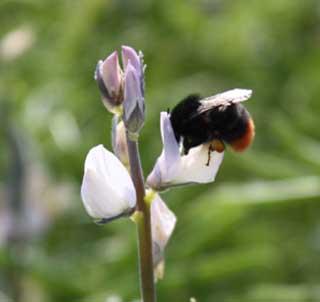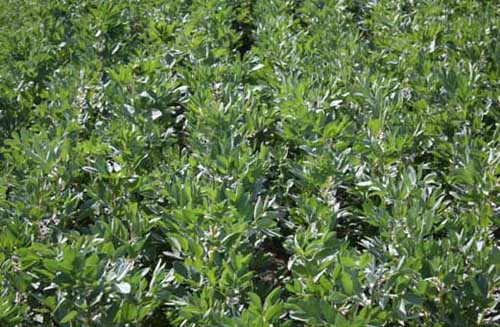Scottish Crop Production Should Rely On Natural & Renewable Sources Of Nitrogen
Published on 26 March 2010 in Sustainability and Communities , Ecosystems and biodiversity

Introduction
Current intense crop production uses large quantities of man-made nitrogen (N) fertiliser at great economic and environmental cost. One way to reduce the reliance on man-made N is to increase the production of legumes. These are crops, such as bean and clover, that support ‘biological N fixation’ (BNF), a natural process carried out by specific types of bacteria, collectively known as ‘rhizobia’, that form a symbiosis with legume plants. The bacteria, living inside swellings on legume roots (root-nodules), convert atmospheric nitrogen gas into plant material. The harvest, being high in protein, has many uses in animal feed and human nutrition, while the residues in the soil provide a nitrogen-rich fertiliser for subsequent crops. Despite their benefits, legume crops have been declining in Europe for several decades as a result of uncertain yields, low economic returns, restricted markets and the ready availability of both nitrogen fertiliser and legume-based animal feed from other sources.
Key Points
The position of legume crops in Europe contrasts with that in certain countries such as Brazil and Australia where production and markets have both increased in recent times. The first step in turning round the decline in legume production was to recognise the great economic and environmental costs of not using legumes centrally in the farming system. Systematic growth of legume production was then achieved by improving crop varieties and matching them with the most effective strains of rhizobia. Finally, the markets for legumes were increased and secured, for example by tying legume production back to livestock production. There is no reason in principle why legume production, with its associated benefits for the wider environment and farmland wildlife, could not increase in Scotland.

Photograph: Vicia faba (broad bean) crop, of immense commercial potential for Scottish agriculture (courtesy of Dr Fred Stoddard, University of Helsinki).
Research Undertaken
Legume production in Europe now occupies around one quarter of its acreage in the early 1960s. A large part of the reason for the decline is the specialisation of farming into sectors that have become increasingly decoupled. For example, the nitrogen for high intensity cereal production is supplied by an industrial process from fossil fuels, while imports from other continents provide the legume-based protein feed that underpins large areas of livestock farming. However, the relatively low cost and ready availability of nitrogen fertiliser and imported, mostly soya-based, feed during the last few decades are unlikely to continue.
Legume crops in Scotland provide several important, quantifiable benefits. They deliver protein for people and livestock. They reduce the use of man-made nitrogen fertiliser, which is the single largest contributor to greenhouse gas emissions in arable farming and a widespread pollutant of water. Home-grown legumes also reduce the transport costs (and associated negative environmental impacts) of importing immense amounts of legume protein from other countries many thousands of miles distant. Whether as a grain legume (for example, beans or peas) or a forage legume, they support the farmland biodiversity and essential food webs that are being diminished by high intensity arable production.
Among the grain legumes, the faba bean has the most promising and positive properties for agro-ecosystems. The faba bean can fix very large quantities of N, much more so than peas, for instance. Much of this N remains in the soil, replacing N fertiliser in subsequent crops. The bean’s deep root system and large root nodule biomass deposit carbon and nitrogen throughout the soil profile, to be used by microbes that undertake the essential processes of soil-formation and nutrient cycling. In addition, the faba bean plant, notably the flowers, and its associated weed flora encourage farmland biodiversity, especially a range of pollinators and other insects which in turn act to regulate pests in other crops. In addition to faba bean, there are opportunities to develop perennial or forage legume crops that also fix large quantities of nitrogen.
Two conditions would be necessary before grain legumes such as faba bean and the best forage legumes are taken up much more widely in Europe. First, their yield needs to be improved, particularly the reliability of their yield in relation to variable weather and the incidence of disease. Second, the range of markets for home-grown legume products needs to be expanded into areas such as processing for livestock and fish farming.
.jpg)
Photograph: Clover, a common forage legume (courtesy of Marilyn Mullay, SAC).
Policy Implications
The development of a national capability to exploit biological nitrogen fixation using legumes would counter the rising economic cost and environmental damage of man-made nitrogen fertiliser. It would lead to a diversification of cropping of benefit to soil health and farmland biodiversity. Progress in achieving this capability would require (a) greater attention by research and advisory services to designing the most beneficial legume-based crop rotations, (b) increased support for the breeding of advanced legume varieties together with selection of the most effective rhizobia and (c) the generation of new and increased markets for legume protein.
Author
Dr Pietro Iannetta, Professor Geoff Squire, both SCRI, Emeritus Professor Janet Sprent, University of Dundee Pietro.Iannetta@scri.ac.uk
Topics
Sustainability and Communities , Ecosystems and biodiversity





